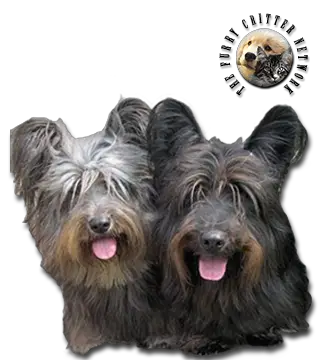Breed Standard
Head: Long and powerful. Slight stop. Powerful muzzle. Strong jaws.
Ears: Small, carried erect, feathered. Drop ears are larger in size.
Eyes: Medium size, close set. Brown color.
Body: Long and short. Oval rib cage is long and well let down. Short loin. Straight back.
Tail: Carried down or in line with the back. Feathered.
Hair: Long, hard, straight, flat, without curl. Short, softer hair on the head veils the face and eyes. Short, dense, soft, wooly undercoat.
Coat: Black, light or dark gray, fawn, cream, with black extremities. Any solid color coat is acceptable. A small white spot on the chest is permissible.
Size: 25 to 26 cm (12.2 in).
Weight: 10 to 12 kg (22-26.5 lb).
History
Scotland has long been a stronghold of small plucky terriers, and the Skye Terrier is among the oldest of them. They developed along the west coastal area, where they hunted fox and otter from among the rocky cairns.
The purest of these dogs were found on the Isle of Skye, and the dogs were then named Skye Terriers. Skye Terriers were first described in the sixteenth century, when it was already noteworthy for its long coat. Some confusion exists in tracing its history because, for a certain time, several different breeds had the same name "Skye Terrier". The loyal dog, present under the petticoat of Mary, Queen of Scots at her execution, has been ascribed as a Skye Terrier. In 1840, Queen Victoria made the breed fancy, keeping both drop-(floppy) and prick-(upwards) eared dogs.
This highly increased its popularity in many of the high societies and among commoners. Soon enough, the Skye Terrier came to America because of its extreme popularity throughout its country and some others. The AKC recognized the breed in 1887, and it quickly rose to the show scene position. Even though this was a strong start and the breed's great appearance, its popularity has dropped. Now it is among one of the least known terriers. Many people are unaware of this breed's old popularity because it is not famous now.
Behavior
This rustic, self-confident dog has a strong personality. He is rather obstinate and stubborn, but is extremely loyal and completely devoted to his owner. He is wary of strangers. Firm training is required.
The Skye Terrier is a hunting dog and enjoys a daily outing, exploring in a safe area. It also needs a short to moderate walk with its owner to stay in shape. The Skye enjoys life as a housedog, and prefers not to live outdoors. So, owners should not keep them outdoors as their natural habitats. Regular combing (about twice a week) is all that is needed to keep the Skye looking well and detangled. Many owners think that an occasional bath will soften the coat, as is often the case with other terriers, but that is not the case. An occasional bath will not soften the coat too much. Owners must pay attention to the area around their eyes and mouth; this may need frequent cleaning.
Function
Pet.
Health
The Skye Terrier is a very healthy breed. The only issue that's a potential concern is orthopedic problems that could occur during growth. The Skye is achondroplastic, meaning that he has a large body on small legs. If he's allowed to jump or climb excessively during puppyhood, before the growth plates in his legs have closed, he may limp or develop a condition called premature closure, which occurs when the growth plates don't close properly.






